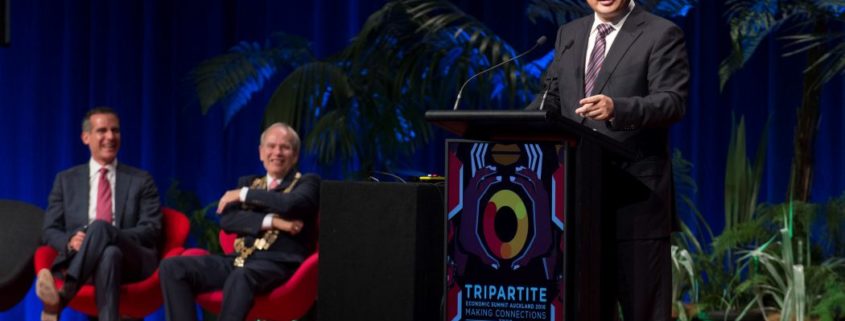Tripartite Summit: Guangzhou – a hub for innovation
- Guangzhou is China’s third-largest city. It has a GDP of similar size to Singapore and Hong Kong, and is undergoing massive transformation.
- The city is moving away from low-cost manufacturing and exports and towards innovation, science and technology, and services for domestic consumption.
- There are various opportunities for Los Angeles and Auckland to be involved in China’s new economic blueprint, and to access Chinese government funding where there is an alignment with the development priorities of each city.
“It is lucky that China has managed to tie all these things together. Seemingly by sheer luck, China has got the mix of timing, location, and people right.” – Derrick Xiong
Delegates to the Tripartite Summit will not have left uncertain of the scale of the opportunity offered by Auckland’s sister city status with Guangzhou.
China’s third-largest city economy is transforming. Even if it wasn’t, the size alone would be opportunity enough: at US$275bn, Guangzhou’s economy is almost the size of Singapore’s and Hong Kong’s in terms of GDP.
Importantly, in the face of growing fears of a slowdown in the Chinese economy, it’s a city which grew 8.3 percent in 2015. That made it the fastest growing of China’s three largest cities, outpacing Shanghai and Beijing by 1.5 and 1.6 percentage points respectively.
As outlined by Rebecca Needham, New Zealand Consul-General to Guangzhou, the Chinese economy as a whole is undergoing a transformation, but Guangzhou is “structurally one of the most advanced cities” on this path.
“What I mean by that is moving away from growth dependent on low-cost manufacturing and exports and moving very much towards growth based on innovation, science and technology, and services for domestic consumption,” explains Needham.
A Chinese government plan in 2008 confirmed plans to make Guangzhou an international hub for science and innovation. That goal is also prominent within the Guangzhou city government’s own five-year plan. Now, eight years into the original plan, and with four years left, Guangzhou has arguably already achieved that goal.
A hallmark of that process has been the development of the Guangzhou National Supercomputer Centre which holds Tianhe-2, the world’s fastest supercomputer. The result of USD$400m of investment by the Guangzhou, provincial, and central governments – and built in an impressively quick 18 months – the Centre offers a huge amount to the city.
“Now, we talk about a new industrial revolution,” said Professor Yuan Xue-Feng, the Centre’s Director. “Characterised by digitalisation, information, networks, intelligent prioritisation.”
Tianhe-2 has fast become the centre of the city’s innovation, with more than 1000 user groups. Applications include material engineering, computational biology and personalized medicine, digital manufacturing, energy-related activities, astronomy geoscience and environmental engineering, and smart-city activities.
The ultimate goal is to “create an ecosystem for research and innovation.”
There are various opportunities for NZ involvement in what Needham refers to as “China’s new economic blueprint”. These have included biomedicine, information technology (with scope for collaboration with the Supercomputer Centre), or even creating a virtual landing pad in Guangzhou through the Innohub connections Auckland has forged of late.
Rapid prototyping is another high-level sector where Guangzhou’s capabilities represent an opportunity for Auckland’s businesses. The Callaghan Institute is currently exploring this, along with scaling-up possibilities around manufacturing, as an option for young New Zealand companies.
“There are also possibilities for Auckland and Los Angeles to access Chinese government funding where there is an alignment with the city’s development priorities,” says Needham.
“There are also possibilities for Auckland and Los Angeles to access Chinese government funding where there is an alignment with the city’s development priorities.” -Rebecca Needham
This new wave of economy for China was reiterated in the Advanced Manufacturing and Automation panel at the Tripartite Summit. Derrick Xiong, of Ehang Inc. referred to the Chinese saying throughout his presentation – “timing, location, and people”.
“It is lucky,” said Xiong, “that China has managed to tie all these things together.” Seemingly by sheer luck, China has got the mix of timing, location, and people right, which has allowed companies like Ehang Inc. to be part of the new era of made in China”.
For New Zealand businesses to be a part of this emerging opportunity will require looking beyond Guangzhou as simply a market for exports, but instead seeing it as an area to form innovative partnerships that add value.




Leave a Reply
Want to join the discussion?Feel free to contribute!